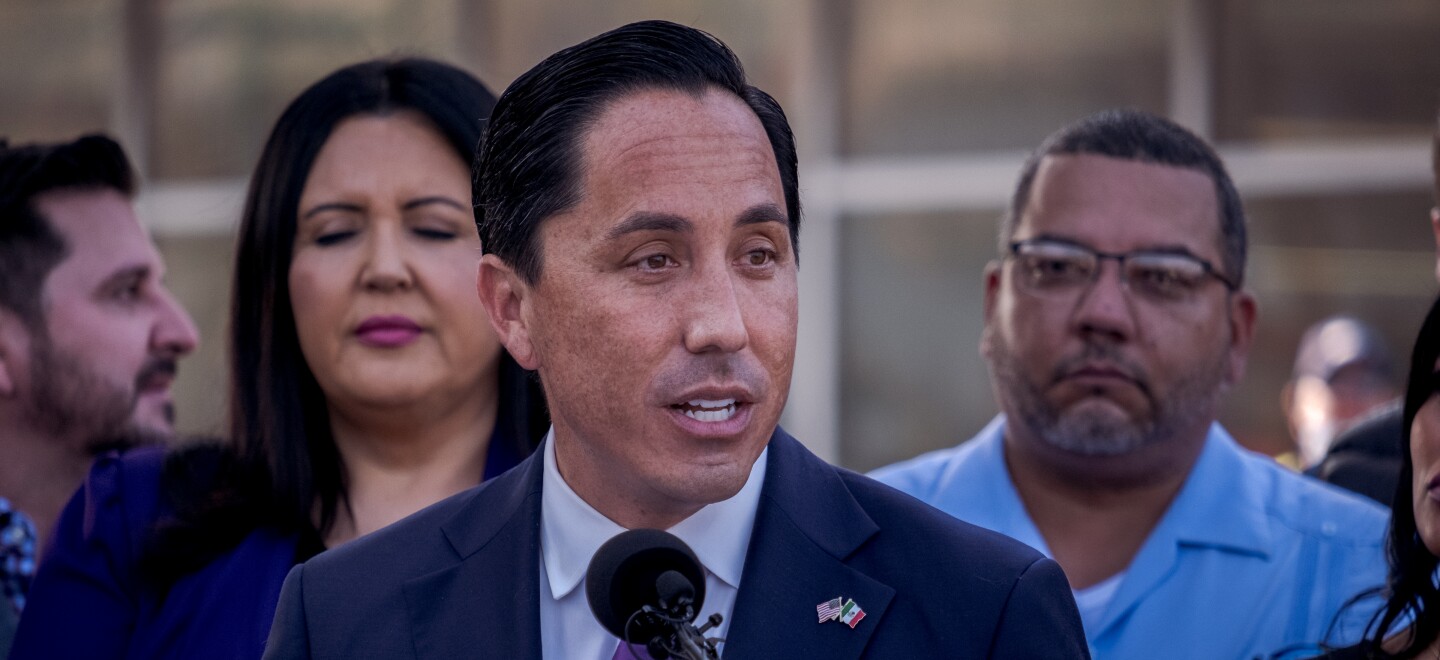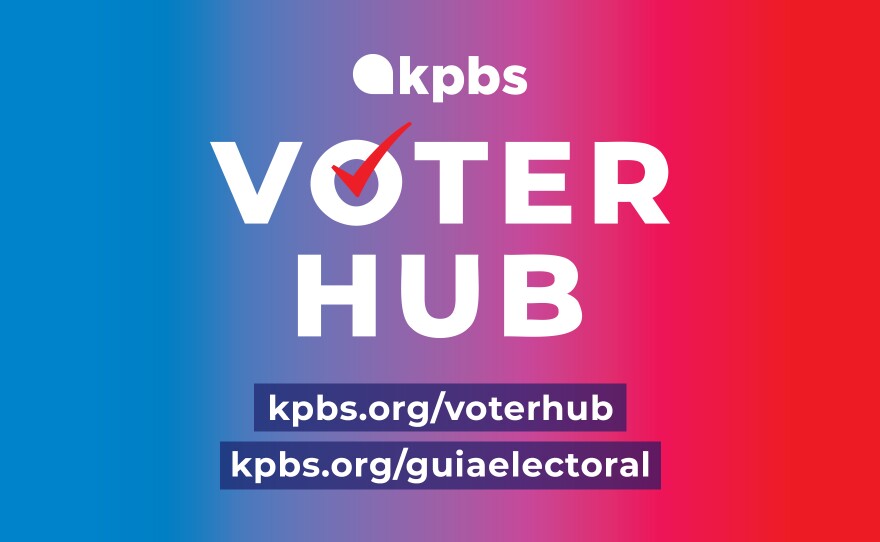More than a year ago, San Diego Mayor Todd Gloria sold elected leaders on a controversial camping ban with a promise: The city would increase capacity for its overburdened homeless shelter system to help move residents off the streets in the middle of a worsening crisis.
Now, just weeks before voters elect the next mayor, Gloria is touting his efforts to keep that promise by “dramatically” expanding capacity, adding more than 930 “shelter beds in just the last 12 months alone.”
But that’s a bit misleading.
More than half of those “shelter beds” are actually tents pitched in two temporary city-sanctioned campsites, which opened in Balboa Park after the city banned camping in public. In reality, much of Gloria’s stated shelter achievements are propped up on short-term deals that are set to expire, as officials anticipate losing more than 600 indoor beds by the end of the year alone. That’s roughly a third of all indoor beds in the city’s shelter system.
And one of the main proposals to permanently replace those beds — leasing and converting a warehouse near the San Diego International Airport into a 1,000-bed shelter — is mired in controversy.
With the clock ticking, Gloria and his staff say they’ve been trying to relocate the beds set to close as well as find other permanent shelter locations. In a recent move, they solicited help from council members, the Independent Budget Analyst’s office and even residents.
On Tuesday, staff updated the City Council on a plan to bridge the gap, adding between 470 and 690 shelter options by the end of the year. A large portion of those would come from expanding already existing campsites and parking lots. That means some people currently sheltered indoors could be moved outside — an irony not lost on some city leaders.
“We’ve got to recognize that we are, in many cases, likely moving someone from a bed in a covered, closed space to a tent or outdoors in a vehicle,” Councilmember Kent Lee said. “It’s frankly not the same, but again, we are facing a bit of a short-term emergency situation.”
Meanwhile, Gloria is asking voters for another four-year term as chief executive of the second largest city in California, applauding his progress while stressing that he needs more time to finish what he set out to accomplish. His opponent, local police officer Larry Turner, says Gloria is out of touch, doesn’t seek community input and hasn’t done enough to reduce the number of folks living on San Diego streets.
In a recent debate, the two mayoral candidates sparred over how best to address the city’s homelessness crisis, which is among the top concerns cited by residents.
Every month for more than two years, the number of San Diegans who fall into homelessness for the first time has outpaced those who move off the streets and into housing. The vast majority of the county’s unhoused residents live in the city, where emergency shelter remains elusive. On any given day, the city’s entire shelter system can reach capacity by noon. Nearly 90% of requests for shelter are denied.
“I want to be very clear,” Gloria said in the recent ABC10 debate. “I am not satisfied and I will continue to push for more sheltering opportunities to get people off the streets.”
Gloria and his team did not respond to inewsource’s interview requests.
On the other hand, Turner said he had hoped the camping ban would mark the beginning of real change in the city, but that hasn’t happened. If elected, he said he would allow officers to ticket or arrest anyone violating the camping ban as soon as they see it — rather than continuing with the current approach that makes an arrest possible only after police have encountered a person three times.
In a recent interview with inewsource, Turner acknowledged that approach might force unhoused residents to flee.

In those cases, “they don’t want the help; they realize San Diego isn’t the place where they can get away with this lifestyle anymore,” he said. “With love and compassion, we are going to make them take us up on this offer (for help).”
But that comes with offering a better place to go, Turner added, and he criticized Gloria for not having more permanent shelter options.
“He’s done all these little Band-Aid approaches and it’s coming back to haunt him,” Turner said of Gloria’s strategy, adding that the mayor should’ve been planning ahead from the start. “And it can’t be swinging for the fences with your eyes closed for 1,000-bed shelter facilities to try to make up for the thousand you’re about to lose.”
When pressed on his plan to expand shelter capacity, though, Turner didn’t offer much of a contrast to Gloria’s approach. Instead, he echoed efforts city officials have already taken — such as turning H Barracks into a shelter, as well as combing through public and privately owned properties.
“There are many things that are quote-unquote already happening, they’re just not happening at the scale that we need it to.”
The search for shelter
Achieving Gloria’s promise has proven difficult. City officials have to consider a number of factors when reviewing sites for a permanent shelter, including the site’s location and characteristics, as well as its proximity to service providers, resources and sensitive areas.
“It’s not as simple as pulling up property listings from your computer,” said Christina Bibler, the city’s economic development director, during a public meeting in July.
Casey Smith, a deputy chief operating officer, said officials have combed through city-owned properties to add shelter opportunities wherever feasible. Since Gloria took office in December 2020, he said the city opened three indoor shelters, two campsites and a parking lot for people to sleep in their vehicle, all on property owned by the city and county. Officials also searched through state-owned property within the city but couldn’t find anything suitable. And now, they’re running out of ideas.
“Our options are narrowing and have been nearly depleted,” Smith said, “and options that we have identified require significant capital investment.”
That leaves private property. And one of the most important factors at play is a property owner who is willing to lease or sell.
“A willing property owner can make or break the success of a non city-owned property,” Bibler said.
Late last year, city staff requested evaluations from the Economic Development Department, which presented 19 locations, according to a spokesperson. inewsource requested a list of private and city-owned properties the city has evaluated, but officials would not share one.
The city’s Independent Budget Analyst raised questions about the city’s process for identifying shelter when evaluating the proposed 1,000-bed warehouse.
The IBA report says, “… the fact that the city is pursuing permanent shelter for the first time at a site that was not identified through routine real estate searches but rather because the prospective owner approached the city suggests either how challenging it is to find an appropriate site, or that the current approach is not the most productive approach, or both."
Gloria has even reached out to residents and private property owners for help, as officials put out a formal request for potential shelter sites earlier this month.
“In addition to our evaluation of city-owned properties that could be put to use as shelter sites,” Gloria said in a Sept. 9 newsletter, “we call on local property owners and managers to step up and help the city identify additional spaces for shelters.”
In an update to the City Council on Tuesday, staff presented a short-term plan to replace the 600 indoor shelter beds that are shutting down by the end of the year. It involved expanding existing campsites, parking lots and indoor shelters, leasing room blocks in hotels, even giving people financial assistance to move out of a shelter. All told, officials suspect this could add between 470 and 690 shelter options to replace what’s lost.
That means, best case scenario, city officials start the New Year with about 75 additional shelter opportunities.
Officials say they already have the money to expand the campsites — they just need to buy more tents. As for the other options, they have $4.2 million available and asked council members to help prioritize.
Council President Sean Elo-Rivera said he wanted staff to put a high priority on financial assistance, pointing out that it could be the catalyst to ending a person’s homelessness: It would be a targeted approach for shelter residents who have a social safety net and the ability to end their homelessness without long term housing subsidy.
“It’s kind of like, ‘mission accomplished’ one person at a time, while also freeing up a bed,” he said, “because we’re not just sheltering people, we are getting people permanently housed.”
What has the camping ban accomplished?
The San Diego City Council narrowly passed the camping ban last June, making it illegal to camp citywide if shelter beds are available, and anytime, regardless of shelter availability, near schools, parks, transit hubs and waterways.
Unsafe Camping Enforcement
To enforce the city’s ban, San Diego police have:
- Conducted 1,000 field interviews
- Issued 117 citations
- Made 26 arrests
*As of Sept. 19, 2024
San Diego police have only made a couple dozen arrests and city prosecutors have only taken up two cases.
But it has had a significant impact. Since the ban took effect, the number of people sleeping on downtown sidewalks has been cut in half.
But it’s not due to a decline in homelessness — the latest count from January, six months after the ban took effect, actually shows an increase. Instead, the ban has caused people without housing to flee to more remote, harder to reach areas — such as canyons, riverbanks and highways — to avoid detection from people and local police. Many of these areas are owned by state agencies, such as Caltrans or the Department of Fish and Wildlife. Some unhoused residents even say they have learned the physical boundaries of San Diego police jurisdiction to avoid enforcement.
The riverbed alone has seen more than twice as many people asking for help since the ban took effect, according to data from PATH, a homeless service provider.
According to Gloria, though, street homelessness has declined in San Diego — if you count the “wildly popular” parking spaces and tents the city has made available. Records show the city’s two campsites have averaged around 83% occupancy in the first half of this year. Even so, parking spaces and campsites don’t count as shelter in the eyes of the U.S. Department of Housing and Urban Development.
At the same time, Gloria criticized CalTrans, saying the state agency needs to “step up and coordinate with the city of San Diego so that when we go out and make contact with folks, they’re not simply leapfrogging around (from one encampment to another), but instead accepting those offers of services and getting off the streets for good.”
Gloria and Turner will have another chance to discuss the issue on Thursday, when they debate again, this time on KPBS.








